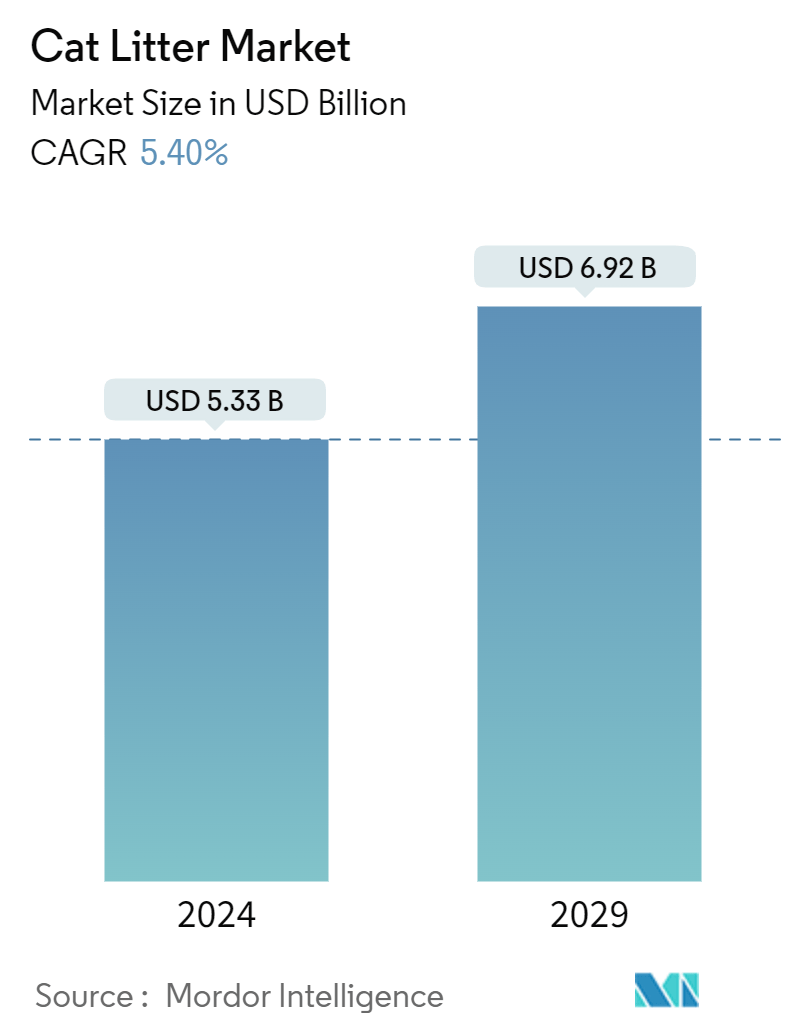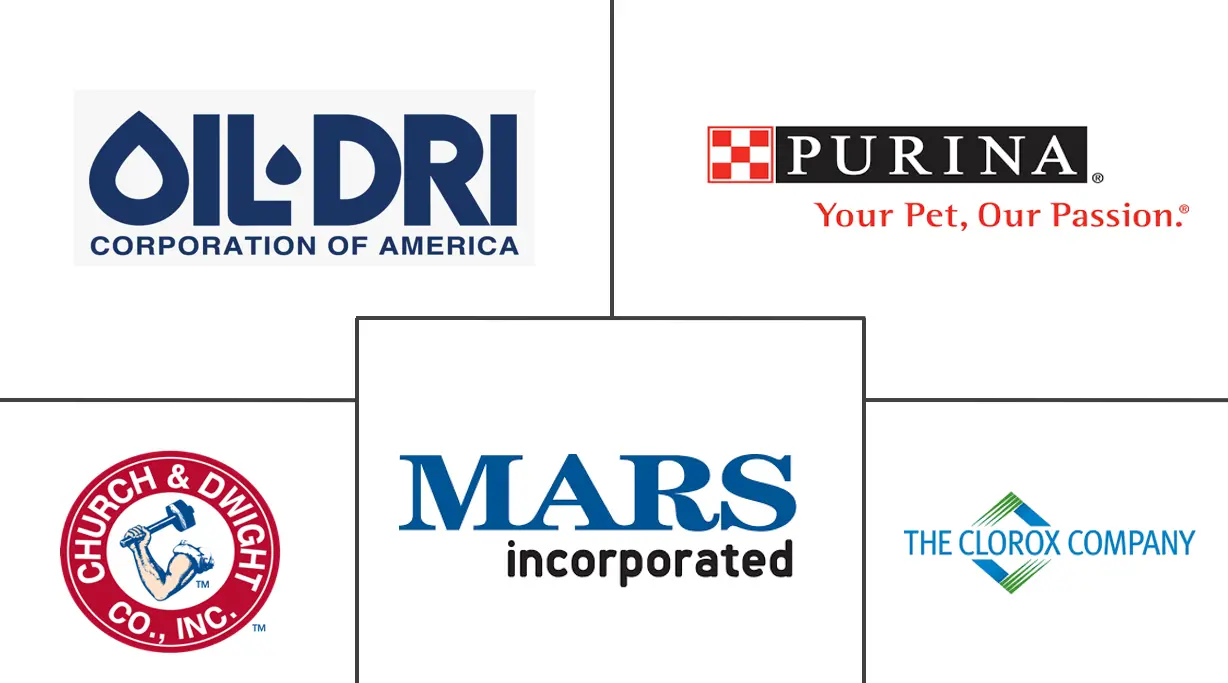Market Size of Cat Litter Industry

| Study Period | 2019 - 2029 |
| Market Size (2024) | USD 5.33 Billion |
| Market Size (2029) | USD 6.92 Billion |
| CAGR (2024 - 2029) | 5.40 % |
| Fastest Growing Market | North America |
| Largest Market | Europe |
Major Players
*Disclaimer: Major Players sorted in no particular order |
Cat Litter Market Analysis
The Cat Litter Market size is estimated at USD 5.33 billion in 2024, and is expected to reach USD 6.92 billion by 2029, growing at a CAGR of 5.40% during the forecast period (2024-2029).
The cat litter market is driven by the increasing adoption of pets worldwide. The recent rise in pet humanization, wherein pets are treated with increased care and hygiene, is proving to be a significant driver for the market. According to the World Pet Association, in 2023, there were over 600 million pet cats globally, compared to 420 million in 2019. The growing demand for innovative products by cat owners is likely to offer lucrative opportunities to players operating in the market studied. Furthermore, due to growing environmental awareness, environmentally conscious consumers seek sustainable, eco-friendly, and ethically sourced alternatives. This trend is prevalent among millennials and Generation Z, who prioritize these aspects when making purchase decisions. Therefore, the key players in the market are launching tailor-made organic products. For instance, in February 2024, PetSafe introduced PetSafe ScoopFree Premium Natural Litter, designed to manage odor for over 21 days. The litter is 100% natural, made from fossilized algae, and contains no additional fragrances, dyes, or chemicals.
Cat Litter Industry Segmentation
Cat litter is one of the major necessities for a cat owner, along with cat food. A litter box collects cat urine and feces.
The cat litter market is segmented by product type (clumping and conventional), raw material (clay and silica), distribution channel (specialized pet shops, internet sales, hypermarkets, and other sales channels), and geography (North America, Europe, Asia-Pacific, South America, and Middle-East and Africa). The report offers market size and forecasts in terms of value (USD) for all the above segments.
| Product Type | |
| Clumping | |
| Non-Clumping |
| Raw Material | |
| Clay | |
| Silica |
| Distribution Channel | |
| Specialized Pet Shops | |
| Internet Sales | |
| Hypermarkets | |
| Other Distribution Channels |
| Geography | ||||||||
| ||||||||
| ||||||||
| ||||||||
| ||||||||
|
Cat Litter Market Size Summary
The cat litter market is experiencing significant growth, driven by the increasing adoption of pets and the trend of pet humanization, where pets are treated with heightened care and hygiene. This shift is particularly evident among millennials and Generation Z, who prioritize sustainable and eco-friendly products. As a result, key players in the market are introducing organic and natural products to meet this demand. The rise in indoor cat ownership, due to concerns like human hostility and adverse weather, has further boosted the demand for cat litter boxes. Clumping litter, known for its superior odor control and convenience, is gaining popularity, prompting companies to innovate and expand their product offerings.
In Europe, particularly in Germany and the UK, the cat litter industry is witnessing a surge in demand due to the increasing number of cat owners and the anthropomorphism trend. This has led to a focus on premium pet care products, creating opportunities for cat litter companies. Retailers are expanding their presence to enhance product accessibility, contributing to market growth. The market is fragmented, with major players like Mars Inc., Nestle SA, and The Clorox Company holding minimal shares, while others account for a significant portion. These companies are engaging in mergers and acquisitions and strengthening their distribution channels to enhance their market position.
Cat Litter Market Size - Table of Contents
-
1. MARKET DYNAMICS
-
1.1 Market Overview
-
1.2 Market Drivers
-
1.2.1 Increased Pet Humanization
-
1.2.2 Growing Trend of E-commerce
-
-
1.3 Market Restraints
-
1.3.1 Rising Cost of Raw Material Production
-
1.3.2 Growing Concern Over Environment and Pet Health
-
-
1.4 Porter's Five Forces Analysis
-
1.4.1 Threat of New Entrants
-
1.4.2 Bargaining Power of Buyers/Consumers
-
1.4.3 Bargaining Power of Suppliers
-
1.4.4 Threat of Substitute Products
-
1.4.5 Intensity of Competitive Rivalry
-
-
-
2. MARKET SEGMENTATION
-
2.1 Product Type
-
2.1.1 Clumping
-
2.1.2 Non-Clumping
-
-
2.2 Raw Material
-
2.2.1 Clay
-
2.2.2 Silica
-
-
2.3 Distribution Channel
-
2.3.1 Specialized Pet Shops
-
2.3.2 Internet Sales
-
2.3.3 Hypermarkets
-
2.3.4 Other Distribution Channels
-
-
2.4 Geography
-
2.4.1 North America
-
2.4.1.1 United States
-
2.4.1.2 Canada
-
2.4.1.3 Mexico
-
2.4.1.4 Rest of North America
-
-
2.4.2 Europe
-
2.4.2.1 Germany
-
2.4.2.2 United Kingdom
-
2.4.2.3 France
-
2.4.2.4 Russia
-
2.4.2.5 Spain
-
2.4.2.6 Rest of Europe
-
-
2.4.3 Asia-Pacific
-
2.4.3.1 India
-
2.4.3.2 China
-
2.4.3.3 Japan
-
2.4.3.4 Rest of Asia-Pacific
-
-
2.4.4 South America
-
2.4.4.1 Brazil
-
2.4.4.2 Argentina
-
2.4.4.3 Rest of South America
-
-
2.4.5 Middle-East and Africa
-
2.4.5.1 United Arab Emirates
-
2.4.5.2 Saudi Arabia
-
2.4.5.3 Rest of Middle-East and Africa
-
-
-
Cat Litter Market Size FAQs
How big is the Cat Litter Market?
The Cat Litter Market size is expected to reach USD 5.33 billion in 2024 and grow at a CAGR of 5.40% to reach USD 6.92 billion by 2029.
What is the current Cat Litter Market size?
In 2024, the Cat Litter Market size is expected to reach USD 5.33 billion.

